Kgalagadi Transfrontier Park - July 2010
It was winter and it was time for our annual long trip. We usually take 3 weeks during the winter just before or after the school holidays to unwind, relax and recharge our batteries. A holiday at home is not worth it so we usually pack our stuff and explore the roads least traveled. This year the red dunes of the Kalahari called us and we answered that call. Unfortunately Kaspaas is out of commission so the Bloukaas/Roque-Ford had the honour to transport us on this trip. A mad rush in the last 2 weeks before our departure date saw brackets being made for the RTT and a portable dual battery system build for the fridge. I removed the rear seat of the DC and we used it to pack the fridge and the cool boxes inside the vehicle. The reasoning behind this was that if it gets warm the air-con will keep the vehicle interior cool and the fridge wont have to work that hard, drawing less current. For the Toyota Hilux Purists, now is the opportunity to stop reading this trip report. You guys are going to be so disappointed, because after this long trip over really bad corrugations and dusty tracks, nothing broke, rattled loose, fell off, stopped working, started leaking, lost oil, got bent out of shape, choked in dust or let us down!! Die Blou Ford Kan, and with a quick wipe of a cloth he's sparkling in the sun again. I am duely impressed.
The Ford was packed and ready for action on the morning of Friday 09/07 and we left work at noon and hit the road. First stop was Swartland 1-Stop to fill up the tank and to reset the GPS and make our last phone calls. The weather was good and in no time we were up over the Van Rhijns Pass and in the Hantam. At Nieuwoudtville we turned north towards Loeriesfontein and stopped at the Nieuwoudtville Waterfall. Spectacular and totally unexpected in this otherwise flat landscape.
The Small Waterfall:

The BIG waterfall:
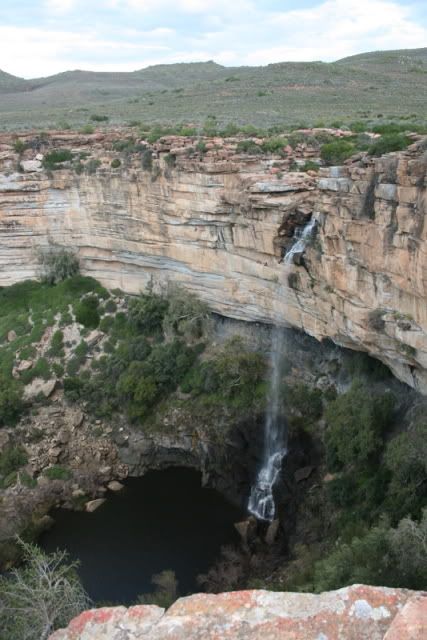
Roque-Ford Bloukaas:
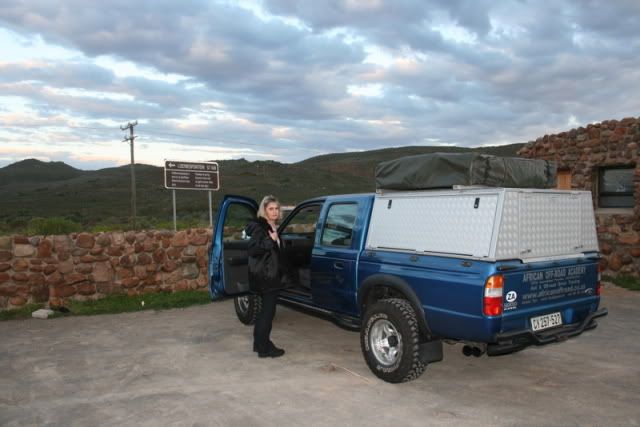
Loeriesfontein is the Windmill Capital of South Africa with a museum dedicated to these water pumping marvels from the veld. We spent the night in the Loeriesfontein Hotel, a typical plattelandse hotel with typical plattelandse hospitality and friendly service. The food was great, and the bed warm. Breakfast was just as good, with lots of coffee!
The next morning when we woke up it was drizzling out and a bit chilly. This was a precursor of things to come. In the main road we were stopped by a man who wanted us to go and buy pannekoeke at the hall across the road, where the local tannies were baking pancakes and selling them to raise money for some worthy cause. We got some regte plaaspannekoeke. After filling up with diesel and pannekoeke we hit the road north via Granaatboskolk, Dwagga Zout and some even more remote places towards Kakamas. It took for ever to warm up, and even at about 12 noon it was still chilly outside. The road is good, there are some big trucks travelling on it, to and from the salt works at Dwagga Soutwerke.
Coffee break:

Approximately 30 km before Kakamas I noticed that the right rear tyre was flat-ish, so we stopped and I took out the compressor and re-inflated it to 2.5 bar. I re-inflated because I didnt feel like unpacking the whole car this close to our destination, and because I was sure that it was a slow puncture. This lasted the 30km into Kakamas, where we stopped at the garage to re-inflate it again. We only just made it to the Augrabies campsite before it was completely flat again. Once the camp was set up I got busy with the jack and the snot-plugs and within a few minutes the hole was plugged and the puncture fixed.
We spent the weekend at Augrabies with my brother-in-law and his family until Sunday morning after breakfast, when they departed for Upington where they live. This is an awesome place and the waterfall is really something spectacular to see.
Augrabies:
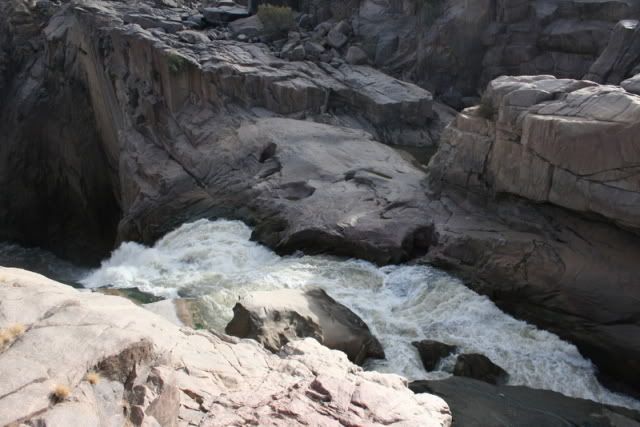

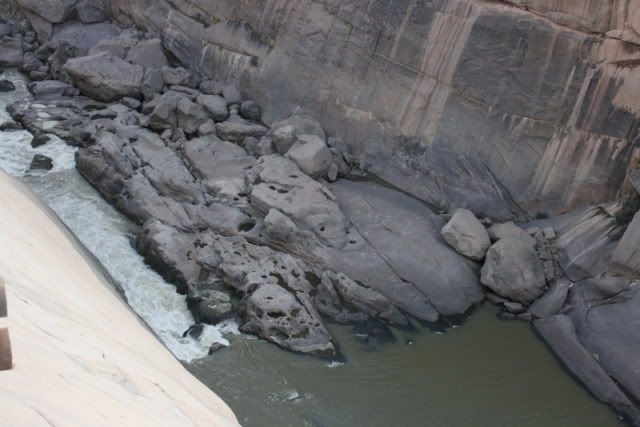

Sunday evening became quite cold and on Monday morning when we broke up camp I suggested that we buy 2 more blankets from PEP to put between the mattress and the floor of the rooftop tent, as the cold from the bottom can cause some serious discomfort. After doing that and having the snotplug checked out at Fit-It, just for my own peace-of-mind, we headed out in a northerly direction again. This time past Lutzputs, Vrouenspan, Swartmodder and Noenieput towards Rietfontein.
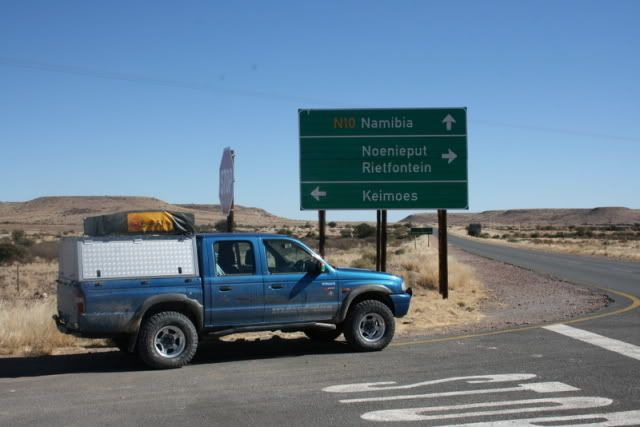
These are desolate areas, not many vehicles travel these roads but the scenery is awesome. That is if you like Kalahari dunes and dry grass. Once we arrived in a little place called Philanders/drif/fontein/pan/rus/poort/vlakte/valley/put or something like that I stopped and asked for directions as the paper map I had, and the T4A map on my GPS and the road-signs along the road did not correspond, so technically we were lost, but we knew where we were, if that makes sense. We were looking for the road to Groot Mier. Yes, said the fella, just keep straight met die pad and you’ll get there, meneer. So straight met die pad it was until about 2 km further we realised this was Hakskeenpan, and the road (if you could call it that) was just a salty crust, and hasn’t been used since the last rains. The pan was dry so we kept going on the 2-spoor track next to the road. According to the GPS we were going in the right direction to arrive at our next waypoint. Halfway across the pan we stopped and got out walked around a bit and had a snack and some afternoon coffee. Way over in the distance we could see the road going over a dune so it looked like we were on the right track.
Haakskeenpan:
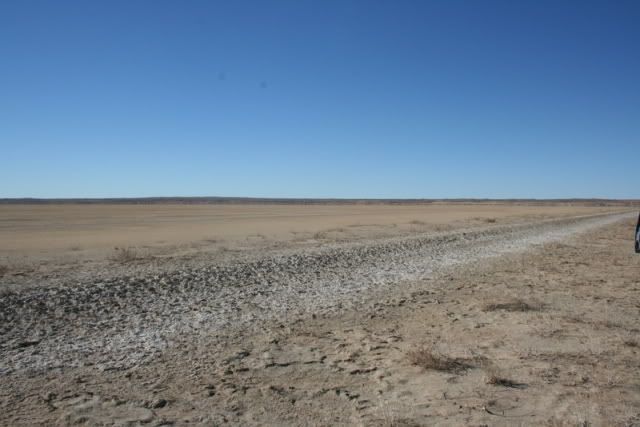

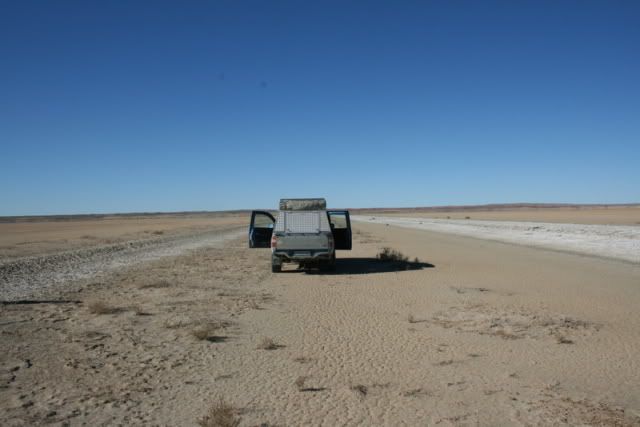
After our brief stop we continued to the end of the pan where we saw that the road was no longer a road, and that the red sand of the Kalahari had blown across the road and that it was definitely not in use any longer. For a short while I thought of driving over the dune to see what is on the other side, but then decided against it, as I was not sure that once we got to the other side that we would be able to make it back to this side of the dune. I had no experience with the Ford on dunes, so I decided not to take the chance. Also, we were so far from help we could be stuck for days before anybody came along to help. We turned around and headed back, until we say another faint 2-spoor track heading off in a northerly direction and we took it. Before long there was about 17 2-spoor tracks but we kept going north (we would hit the Mediteranean eventually and then we can back-track from there) and after about 2km we hit the R31 Rietfontein/Askham road. Teerpad nogals and about 50km further north than indicated on all my maps!! From there it was a quick hop-skip and jump past both Groot and Klein Mier to where we booked in at Twee Rivieren and pitched camp for the next 2 nights.
Twee Rivieren:

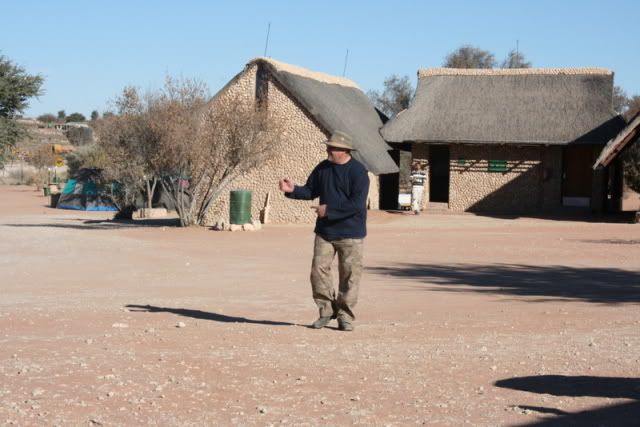
That Monday night we experienced polar bears and penguins and there were eskimo’s too! The mercury dropped to -7Deg C. It was frikkin-frizzin. Good thing we had the 2 extra blankets, we would have frozen solid without them. At about 10am on Tuesday the thermometer still read about -2Deg C. We sat in the sun all day long trying to heat our frozen bones, but to no avail, because the slightest breeze seemed to cut through everything and chilled us to the core. The only time we got some heat into our bodies was when we took a little game-drive and had the heater on full blast. Tuesday night was slightly better with the minimum dropping to -4Deg C.
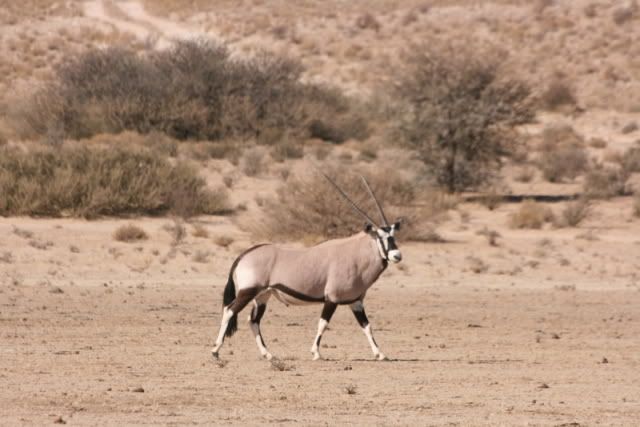

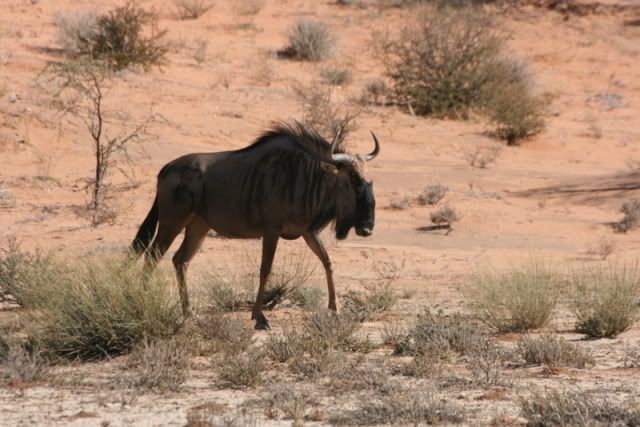
Die sekretaris se voël:

Good thing we left Twee Rivieren on Wednesday for Nossob camp further north far away from the influences of the cold fronts that came in over the Cape. The drive to Nossob was nice and warm, with some wildlife sightings, mostly gemsbok, blouwildebeest, springbok, ostrich, rooi hartbees and jackal. Arriving at Nossob there was a strong breeze whipping up dust-devils in the camp site so we picked a spot closest to the fence and upwind from the rest of the camp. The night was noticeably "warmer" than before although it was still quite cold.
Next morning we broke up camp and headed for the Gharagab Wilderness Camp, way up north in the dunes. By this time our breaking-up-the-camp skills (in the cold with freezing fingers) were finely honed and we managed to do it in less than an hour. With a coffee break in between to warm the fingers and make sure they still there. This includes a ground tent, 2 ground sheets, RTT, chairs and tables and lights.
On our way to Union’s End we saw them. In the long grass on the left hand side of the road 2 cheetah heads appeared, about 50m away from the road, and we stopped. They calmly sat there in the grass checking us out, and slowly started walking towards the front of the vehicle. When they crossed the road we saw that they were actually 3 young females, with no cubs. Once they got to the other side they sat down on the shoulder of the road, checked out the menu in the Nossob riverbed for about 10 minutes, and then walked back across the road again. Once in the grass they disappeared all together. Amazing!
Cheetahs:
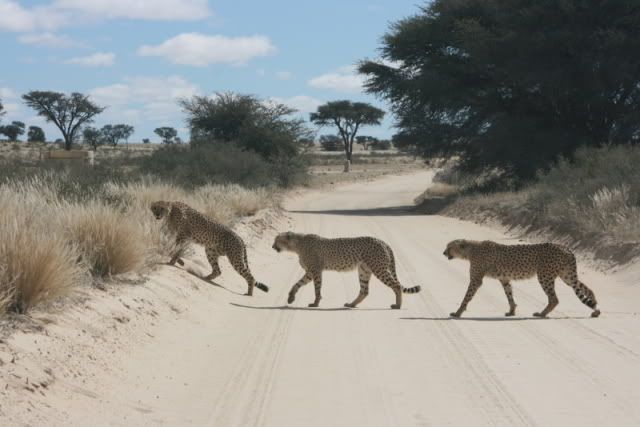

Union's End:

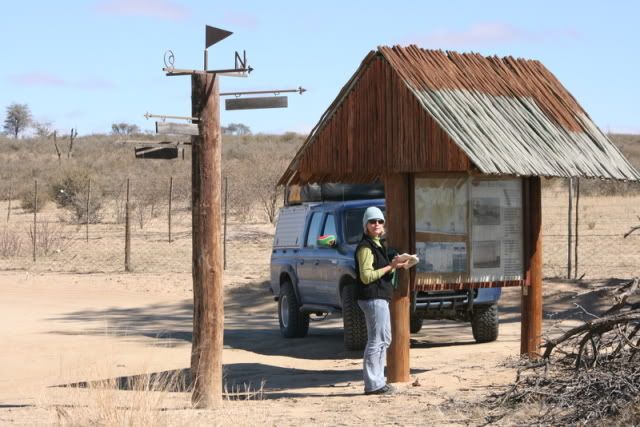
After our brief stop at Union’s End (this is just something we HAVE to do when we come to KTFP) we took the dune track to Gharagab. About 40km into the dunes away from the hustle and bustle of the main roads there are 4 log cabins set on the side of a dune, with a view over a waterhole. This camp is unfenced, so walking around at night is definitely not safe, and wandering too far away from your cabin during the day is also not really recommended. But the peace and quiet is amazing. (Un)fortunately no kids under 12 allowed, and only 2 people per cabin, so there are a maximum of 9 people in the camp at full capacity, and that includes the game warden.
Cold:
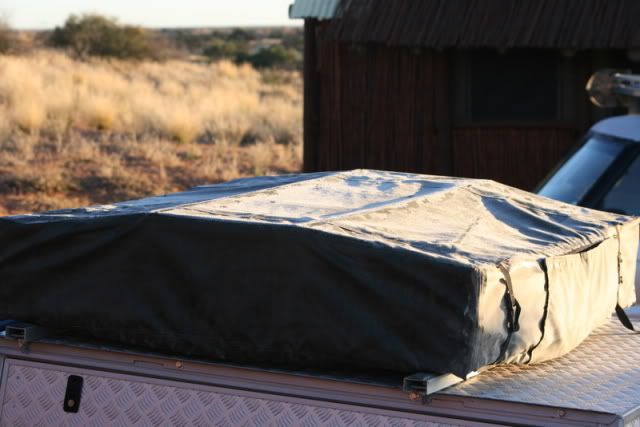
Gemsbok at Gharagap:
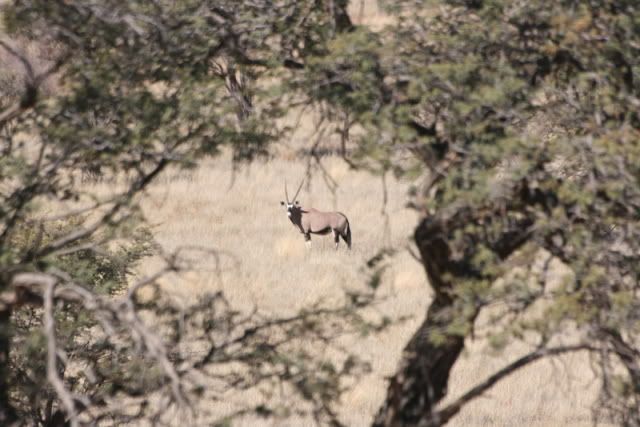

Sunset :
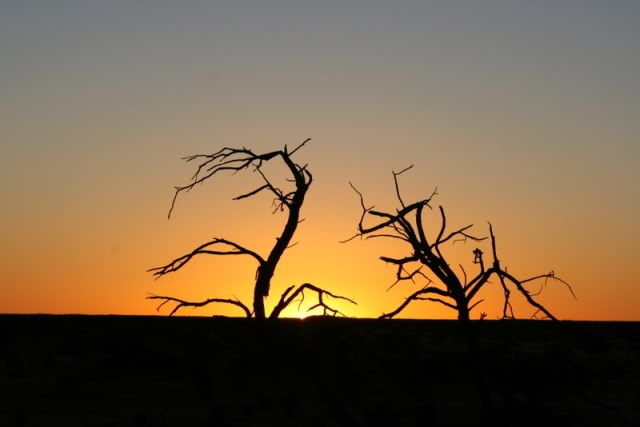
Catch that lion!
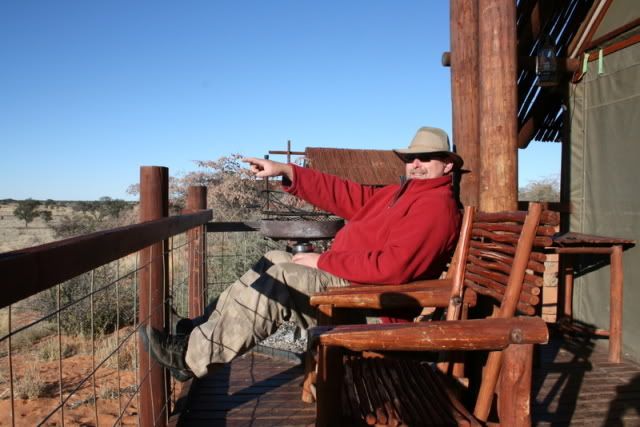
Breakfast:
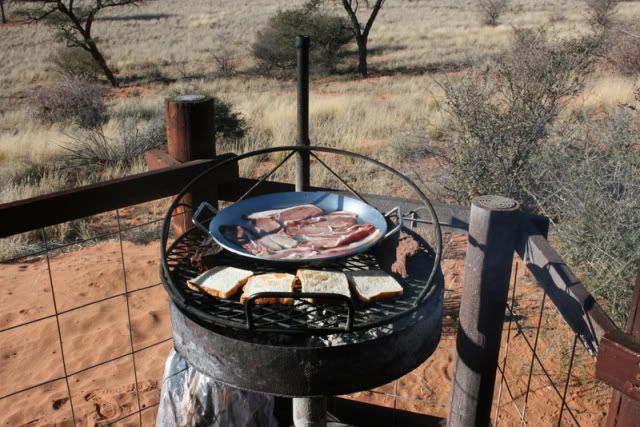
We spent 2 nights at Gharagap. On the second night, after sitting in the sun on the deck all day watching gemsbok, ostrich, jackal and a host of other wildlife coming for a drink at the waterhole, we turned in early-ish, about 9pm. We were the only inhabitants of the camp that night. The weather was quite noticeably warmer.
At about 2am we were woken by the roars of 2 young male lions. AWESOME! It sounded like they were roaring right next to our cabin. We jumped up and ran to the front glass doors, overlooking the waterhole, but couldn’t see them, it was too dark. They kept on roaring around the camp for hours, keeping us awake. The camp attendant showed us their spoor the next morning, and told us he saw them drinking at the waterhole again just before dawn.
Unfortunately we had to get moving back to Nossob, but after a hearty breakfast of bacon and eggs and toast prepared on an open fire we hit the road. All the way back on the 2 spoor track we stopped from time to time spotting gemsbok, blouwildebeest, gompoue and steenbokkies. No sign of the lions of the night before. Probably sleeping it off after "kattemaai-ing" all night long.
Once back at Nossob we pitched camp on the same site we occupied before. We also noticed that our neighbours from across the road was still camped in their spot but their car wasn't there, they were out in the park on a game drive. By dusk Saturday evening we got worried and some of the people went to inform the park rangers that these people were not back in the camp yet. Sunday morning they were not back yet but we thought they probably went and slept over at one of the wilderness camps where trailers were not allowed. When we went to the camp office that afternoon we heard that these people were still missing. By about 6pm we noticed people at their tent and there they were, without their vehicle.
This is what happened:
Our neighbours across the street, a pleasant older couple called Fanus and Ruth from Grabouw in the Western Cape, decided to go for a drive on Saturday at around 9am. The informed the Park-office that they will be travelling in a Southerly direction, stopping and viewing game at waterholes along the way. They got bored with the viewing south and decided to go north of Nossob, without informing the park-office of their intentions. While driving around on the northern side, they turned off into a "No Entry" road to see what's behind the next dune. Can you see where this is going? Not yet? About 7km away from the main road, the Jeep they were driving decided that it is time to break down. The cam-belt went. They were stuck and in deep doo-doo. They had very little water with them, no food, no warm clothes, and Fanus didnt have his heart pills with him.
They sat around waiting for somebody to come along and help, but nobody came because nobody travels on that road. Also because they said they were out South, the search was focused on the area to the South, and nobody was looking for them out to the North. Luckily they did one thing right, they stayed with the vehicle. It was too dangerous to walk back to the camp because of lions and cheetahs in the area, so they decided to wait. That night they slept sitting upright on the front seats of the jeep, and although it was not really cold, they must have been freezing as they were lightly dressed and only had jackets with them. Thye made fires and smoke to attract attention, but these were not seen by anybody. Eventually late on Sunday afternoon some park employees decided to check out the "No Entry" roads to the North, and they were found, no more than about 10km from the camp. The jeep was recovered on Monday morning, eventually flat-bedded out to Upington where they attempted to fix it, but eventually it ended up on a MacDonalds Transport truck to Grabouw. At one stage I offered to tow their Jeep and trailer to Twee Rivieren as we were going that way anyway, but they got sorted out with a flatbed truck which took them all the way to Upington. We made good friends and when we met them in Upington Fanus jokingly said that he is going to sell the Jeep and buy a Hilux D/C 4x4.
Jeep on it's way home:

The lessons to be learned from Fanus and Ruth is to never travel alone without: somebody knowing where you are going,
some water to last for a couple of days at least,
your medication,
warm clothing or a blanket if you know it gets cold at night.
The most important thing is not to wander off the tracks and not to take "No Entry" roads when you're not supposed to go there.
After the Nossob experience we struck out for Kieliekrankie and a night of luxury with proper beds and a shower where the floor is not wet and cold. Getting dressed in the showers in the ablution blocks when it is that cold is a skill that takes some time to master, and a break from that is welcome every now and then. It was like being in the Mount Nelson in the Kalahari, extremely luxurious after our week of camping in the cold and the dust. On our way to Kieliekrankie we spotted 3 cheetahs across the riverbed and stopped. Some other cars also stopped and we sat and watched the cheetahs for almost an hour. A couple of springbokkies walked past not 200m away from where the cheetahs were lying in the shade, but the cheetahs seem uninterested. After about an hour of watching we decided to press on. BIG MISTAKE! Some guys who also stayed over at Kieliekrankie told us that about half an hour after we left the 3 cheetahs caught a springbok right there where we were parked. The next morning we went back and there was a jackal playing with the skull getting the last bits of food off the bones.
Touch, pause, engage!:
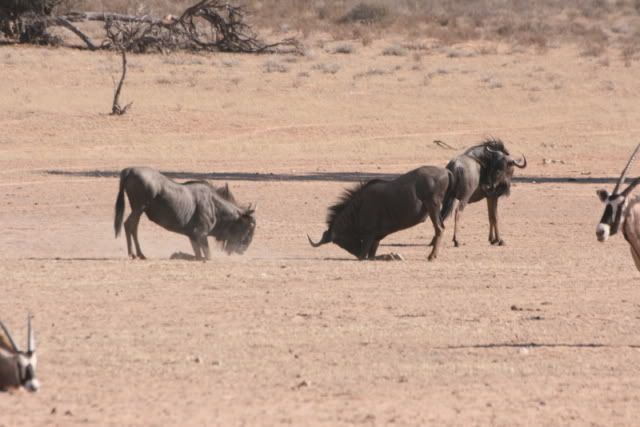

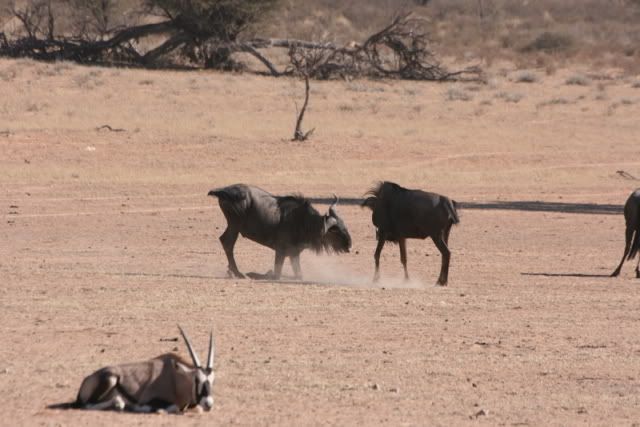
Our last night in the Park was at Twee Rivieren. The trip from Kieliekrankie to Twee Rivieren is not even an hour's drive and at Auchterlonie we stopped at the picnic spot and bumped into a very familiar Hilux. It belonged to one of my African Off-Road mates, Mario the Cook, and with him was Dirk Theron from Hodge Travel. What a pleasant surprise, we had some coffee and a long chat. By now the weather was nice and we were wearing t-shirts.
Spotty:
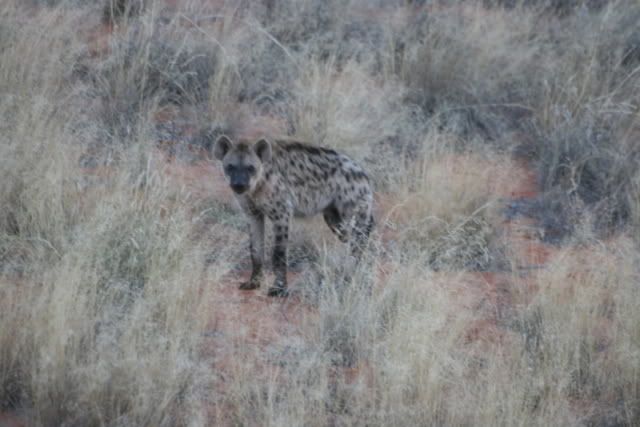
VHF and 29mHz
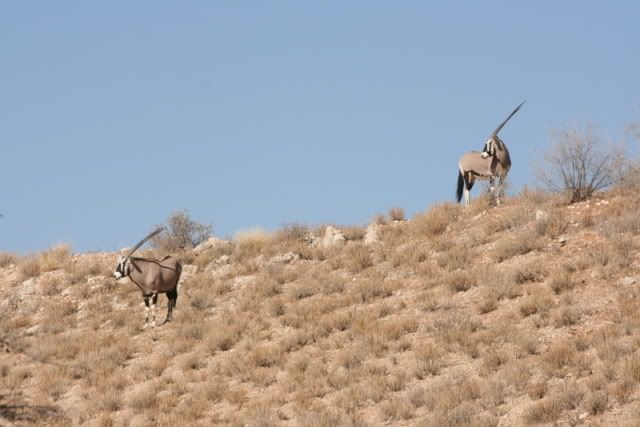
Antie Lou:
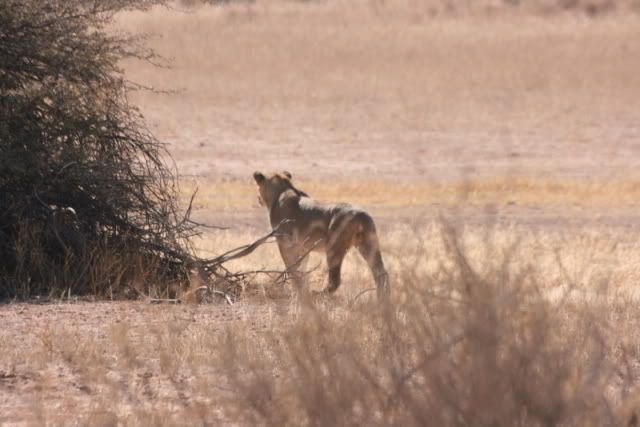
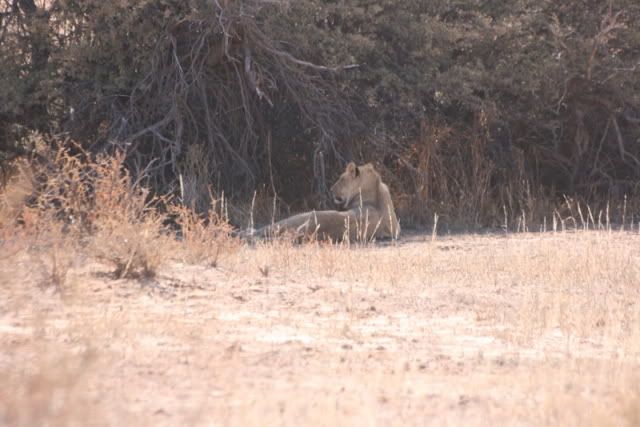
Groot Keelseer:
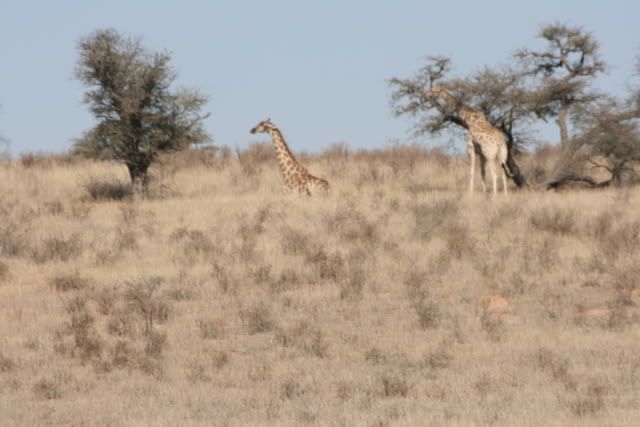
From Twee Rivieren we left through the Mata Mata Gate for Koës in Namibia to visit some family. All the time we were in the park we only saw 2 lionesses waaaaay off in the distance, and here on our last day en route from TR to MM we stopped 3 times watching lions lazing in the shade of the thorn trees in the Auob river.The border crossing was pretty painless, but the Namibian Road Tax is now R200 and not R160 as I was told. No problem we sold the empty coke bottles at the cafe to raise the extra R40. The Namibian dirt roads are still in extremely good condition, and quick quick we did the 130km from the Mata Mata Gate to Koës. Just a footnote for those who know Koës, and who haven't been there for a while, Koës now has a tarred main road!
From here on our holiday became pretty much a family orientated affair as we spend a few days in Namibia with family, and then came back via Aroab and Rietfontein to Upington to visit my brother-in-law and family on the farm. At this time we both came down with a stubborn cold and snotsiekte, and decided to cut our holiday short by a few days. We were supposed to spend 2 days camping at Kalahari-Witsand but reconsidered as we didnt want to tempt fate. We ended up staying in Upington one day longer to recover and then returned home on the Tuesday.
After spending 9 spectacular nights in the Kalahari Trans Frontier Park we came to one conclusion, it is not enough! Next time we'll spend 14/16/18/20 nights and still come to the same conclusion.
The Ford behaved himself perfectly, and never put a foot wrong. Fuel consumption is a little on the high side at 7.5km/l but then again 2300km of the 3800 km travelled was on dirt roads, with tyres deflated to 1.3 bar, and in 4H. The 2.5 TD motor does not like highway speeds in excess of 120km/h and on our way home on Tuesday we did long stretches at 140km/h(+), especially between Kenhardt and Brandvlei. I think the RTT causes a lot of drag as well at that speed.
Lessons learned:
Beer Shandies have a place and are great thirst quenchers, especially when pitching camp in the late afternoon.
A little bit of friendliness goes a long way with border guards.
DONT feed the baboons.
I need another camera. Switching lenses is a bugger.
There is a lot of land out there that needs explorin!
Maps lie.
Some more piccies here: http://s235.photobucket.com/albums/ee26